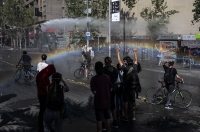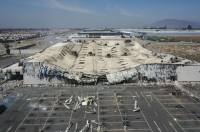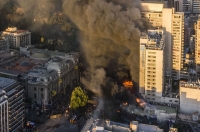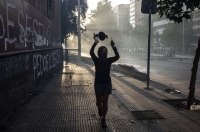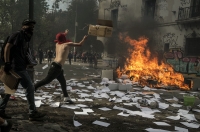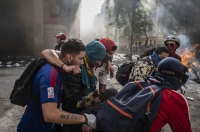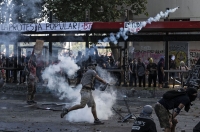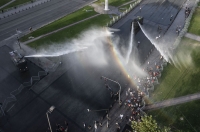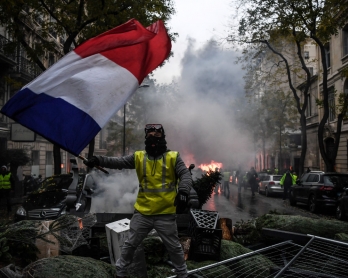When unrest is at home
Santiago -- It’s always easy to see in hindsight how civil unrest erupts. But you never know how it will end -- peacefully with change for the better, or spiraling further and further out of control. Which can be unsettling when the unrest explodes in your home country.
I started listening to the radio as soon as I landed in Santiago on Sunday, October 20th. “People are coming out of shops carrying anything they can.” “They are looting and destroying everything and police are nowhere to be seen!” “This is really chaotic, people have started to organize themselves to protect their belongings.” It was surreal to hear these news reports. I have covered violent unrest in other countries in Latin America, in Asia and in the Middle East. But I never imagined I would be doing it in my home country.
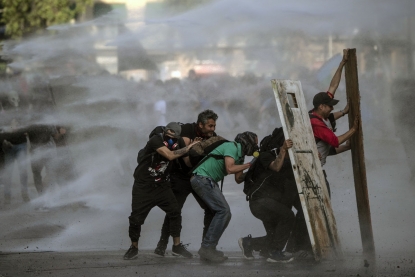 Demonstrators clash with riot police during protests against the government economic policies, in the surroundings of La Moneda presidential palace in Santiago, on October 29, 2019. (AFP / Pedro Ugarte)
Demonstrators clash with riot police during protests against the government economic policies, in the surroundings of La Moneda presidential palace in Santiago, on October 29, 2019. (AFP / Pedro Ugarte)Students called for a boycott of the subway on October 7 after the government announced a fare increase. Although the increase was modest -- 800 to 830 pesos (1.13 to 1.15 dollars) -- the students’ outrage struck a chord in much of the country where prices on everything from medicine to university education have been steadily rising out of reach for most of the population for years. With a very erratic government response, the situation quickly deteriorated and on October 18 the protests descended into violence, burning, looting and clashes with police.
By the time I arrived, curfew had been imposed and the army called into the streets to enforce it -- an ominous step that revived bad memories and fears in Chile, which in the 1970s and 1980s lived under the military dictatorship of Augusto Pinochet.
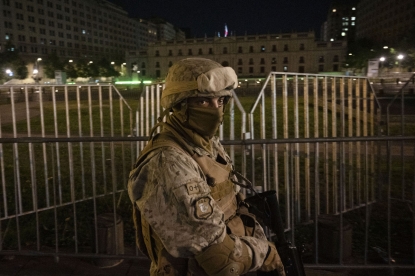 Soldiers patrol the presidential government palace during curfew in Santiago, Chile on October 21, 2019. (AFP / Pedro Ugarte)
Soldiers patrol the presidential government palace during curfew in Santiago, Chile on October 21, 2019. (AFP / Pedro Ugarte)I was at my hotel already at 6 pm, when the curfew went into effect. I was on the 12th floor and the sunset painted the city stretched out in front of my windows yellow. I could see a couple of helicopters hovering over two different columns of smoke on the horizon. I opened the window. As the sun went down, a strange silence seemed to cover the city. It was like a whisper of strong turbines really far away. I couldn’t stop thinking about the late 80s, when my friends and I had to lower our voices and cover our mouths if we wanted to talk politics on our commute to high school.
The protesters’ demands evolved as quickly as the demonstrations themselves. It started with scrapping of the subway fare increase. Later was better salaries and pensions and an improvement of the public health and education system. Then came Pinera’s resignation and soon they wanted a change to the constitution, which was drafted during Pinochet’s era.
One of the surprising things about the protests was just how many people sympathized with the demands of the protesters. It wasn’t just the down-trodden on the streets -- seemed like the entire middle class of Chile was behind the demands. In my circle, everyone I knew, whether politically active or not, was supporting the protesters' demands. One of the reasons is that even though Chile has been doing well macro-economically, salaries and pensions have been low and the cost of living keeps increasing, making access to good health care and education too expensive for most people, including the middle class.
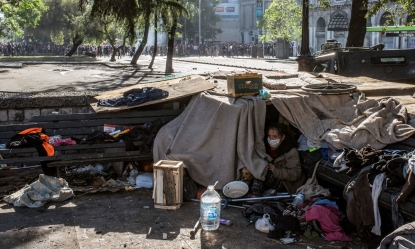 A homeless woman protects herself as riot police clash with demonstrators during scuffles in Santiago, on October 28, 2019. (AFP / Pedro Ugarte)
A homeless woman protects herself as riot police clash with demonstrators during scuffles in Santiago, on October 28, 2019. (AFP / Pedro Ugarte)The slogan of the protests quickly became “it’s not 30 pesos but 30 years,” highlighting the disenchantment with the political and economic elites from the start of democracy. People now wanted deep structural reforms, starting with changing the constitution.
As a news photographer, one of the main challenges is to find an image that you think conveys the gist of the story you are covering. Sometimes you do it in a single frame, sometimes in a series of pictures.
I got a shot like that on October 22, when I was on Plaza Italia, renamed as Dignity Square by demonstrators, the epicenter of the protests. The police were shooting tear gas and using water cannons and the barricades started to burn.
I saw a young man carrying a banner reading “New Constitution or Nothing.”I followed him with my lens and shot a few frames as he walked in front of the fire. In a situation like that, you never know what you’ll have --- you’re wearing a gas mask and dividing your attention between what’s going on in front of you in order to capture it in the most compelling way, but you’re also trying to minimize the risk of pellets fired by police and stones. So it wasn’t until a few hours later when I sat down in front of my laptop to edit my images that I realized the photo was quite powerful -- the man holding up the banner with the demand, framed by huge flames. I thought the image captured the mood on the streets where many people seemed ready to pay a high price to change the constitution.
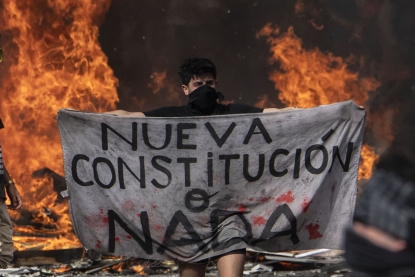 A protester holds a piece of cloth reading New Constitution or Nothing during a demonstration at Plaza Italia in Santiago, on the fifth straight day of street violence which erupted over a now suspended hike in metro ticket prices, on October 22, 2019. (AFP / Pedro Ugarte)
A protester holds a piece of cloth reading New Constitution or Nothing during a demonstration at Plaza Italia in Santiago, on the fifth straight day of street violence which erupted over a now suspended hike in metro ticket prices, on October 22, 2019. (AFP / Pedro Ugarte)One of the most striking things about these protests for me was the bipolar dynamic of the city center. Every morning the day would start as a normal day, with thousands of people heading to work. You’d be reminded that times were not quite normal by the presence of army soldiers in the streets and the destruction left behind from the previous protests. Around noon, the demonstrations would start, traffic in the main avenue would stop and people would peacefully demonstrate. Then the police would stop them, use water cannons and tear gas to try to disperse the crowd, rocks would start flying and the violence would escalate from there.
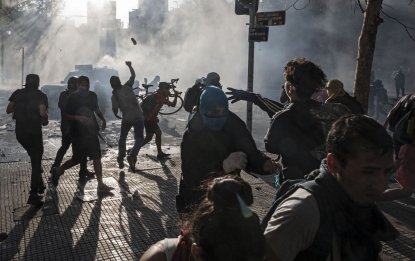 Demonstrators run away from security forces during clashes in Santiago, on October 24, 2019. (AFP / Pedro Ugarte)
Demonstrators run away from security forces during clashes in Santiago, on October 24, 2019. (AFP / Pedro Ugarte)One evening, after a particular violent day, bureau chief Paula Bustamante and I walked the two blocks from our office to our hotel in Alameda. The curfew had just been lifted and the street was dark, full of debris, littered with garbage, smoking barricades, traffic lights destroyed, shop windows broken. It looked like a war zone.
As we approached the hotel we saw a group of people looting a shoes and cosmetics store next to it. We just walked past them, not looking at them, I didn’t lift a camera, nothing. Once inside the hotel we realized the staff had moved furniture to block the doors. How many guests are left? Paula asked. With you, it’s about 12, we were told. We looked at each other. The sounds of metallic bangs could be heard on the street outside as looters were trying to break into other shops. We didn’t feel safe enough and decided to move to a different hotel. The wait for the car to pick us up was quite tense -- we could see organized groups looting the shops around the hotel. I knew that feeling from before, from places and situations far away -- Gaza, Pakistan, Haiti but it was the strangest thing to be experiencing it in my own country.
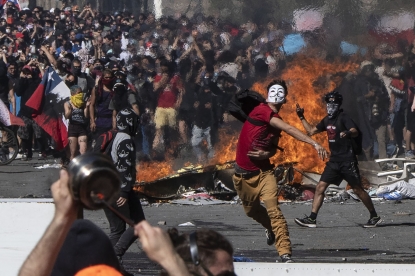 People demonstrate at Plaza Italia on the fifth straight day of street violence which erupted over a now suspended hike in metro ticket prices, in Santiago on October 22, 2019. (AFP / Pedro Ugarte)
People demonstrate at Plaza Italia on the fifth straight day of street violence which erupted over a now suspended hike in metro ticket prices, in Santiago on October 22, 2019. (AFP / Pedro Ugarte)I went to high school in Chile in the late 1980s. At parties we would dance to the rhythm of famous South American rock bands: Soda Stereo, Charly Garcia, Sumo, and of course Los Prisioneros. Their most famous song was “El Baile de los que Sobran,” (The Dance of Those Left Behind) with lyrics speaking about those left behind by the system.
How odd it was then, 30 years later, to hear it become the anthem of the protests. I heard it everywhere I went and saw thousands jumping, dancing and singing to it, just like my friends and I did thirty years ago. I guess the song explains as well as anything else what exactly is happening in Chile. I would look at the people dancing and singing the lyrics and think “why on earth didn’t anyone take this song seriously when we had the chance?”
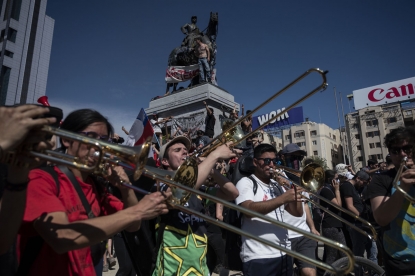 People play their musical instruments during a demonstration at Plaza Italia in Santiago, on the fifth straight day of street violence which erupted over a now suspended hike in metro ticket prices, on October 22, 2019. - (AFP / Pedro Ugarte)
People play their musical instruments during a demonstration at Plaza Italia in Santiago, on the fifth straight day of street violence which erupted over a now suspended hike in metro ticket prices, on October 22, 2019. - (AFP / Pedro Ugarte)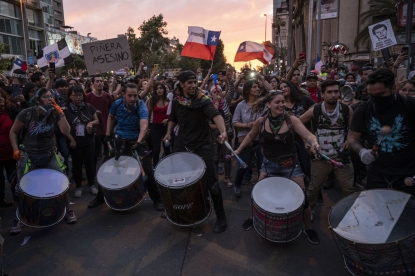 Demonstrators play the drums in Santiago, on October 25, 2019, a week after protests started. (AFP / Pedro Ugarte)
Demonstrators play the drums in Santiago, on October 25, 2019, a week after protests started. (AFP / Pedro Ugarte)
One of the moments that made the biggest impression on me during these protests came on October 26, where there was a call for a huge march on Plaza Italia. I was in charge of aerial footage with a drone for the demo. There were so many people that I literally had minutes when I just couldn’t move. It took me an hour and a half to cross the square to find a spot from where I could launch the drone. As I was trying to cross that sea of humanity, a few people in masks tried to break into a shop. But suddenly what seemed like thousands of voices started shouting “No violence! Without violence!” And they made the masked men stop.
I launched the drone and with it looked for Baquedano’s statue that has become an iconic part of the plaza. But to my surprise, I realized that the human sea had swallowed it up. I didn’t have a point of reference. Lifting the drone, higher and higher I saw the scale of the demonstration on the screen of my phone and it just took my breath away. By the end of the day even the government acknowledged that 1.2 million people had come out.
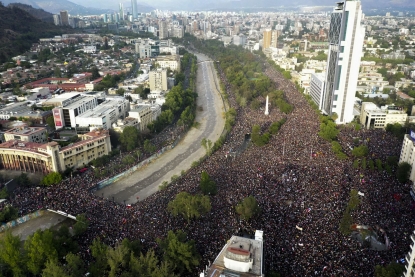 In this aerial view thousands of people protest in Santiago, on October 25, 2019, a week after violent protests started. (AFP / Pedro Ugarte)
In this aerial view thousands of people protest in Santiago, on October 25, 2019, a week after violent protests started. (AFP / Pedro Ugarte)The protests in Chile are now in their fifth week.
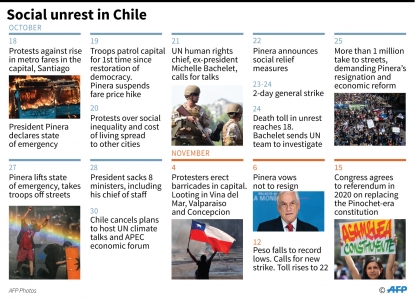 (AFP Graphics)
(AFP Graphics)You never know how civil unrest will end. But that night, thinking back to that huge march, and how thousands stopped a few from escalating the situation made me feel a bit lighter. I am convinced that we have a great opportunity ahead of us now in Chile. But I am not taking anything for granted.
This blog was written with Yana Dlugy in Paris.
